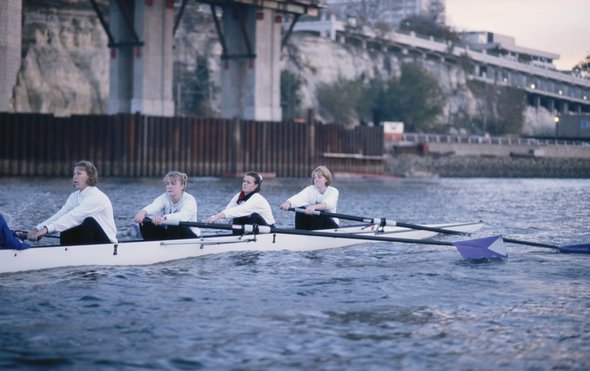(单词翻译:单击)
听力文本
This is Scientific American — 60-Second Science. I'm Karen Hopkin.
Picture a women's crew team. Training 18 hours and covering 75 miles in an average week, these athletes are pretty ripped. Yet they don't hold a bicep to prehistoric female farmers. Because a new study shows that, based on upper arm strength, the Neolithic ladies leave modern women—even elite athletes—in the dust. The work appears in the journal Science Advances.
The study's researchers had previously examined the bones of prehistoric men. Because bones adapt to the load they bear, they can provide a record of the sort of activities in which an individual regularly engages. So, at the dawn of agriculture, men's leg bones were strong, like today's cross-country runners. But by the late Iron Age, their leg bones looked more like that of the average couch potato.
"So this kind of matched with declines in mobility as people became more sedentary through time."
Alison Macintosh, who did that work when she was an undergraduate student in archaeology at the University of Cambridge.
"But we didn't see these drops in women. Their leg bone strength was consistently lower than men's, it didn't change significantly through time. So really the women just looked quite sedentary pretty much right from the get-go. And we didn't think that was very probably necessarily a very accurate representation of what they had been doing."

Now, it could be that prehistoric housewives sat around and lunched their way through the Neolithic. But Macintosh thought that unlikely. Instead, she and her colleagues figured that the bones of men and women react differently under pressure. So Macintosh, now a postdoctoral fellow with the same group, decided to look at the limbs of some ladies.
She recruited 18 championship rowers, 11 soccer players, 17 runners and 37 somewhat less sporty undergrads. And she scanned their upper arms and lower legs. What she found is that the leg bone strength of prehistoric women was as variable as that of her living subjects, running the gamut from those who run marathons to those who engage in marathon study sessions. But the arms were a different story.
"We found that prehistoric women had stronger arm bones on average than most living women. That was pretty consistent through the first 5,500 years of farming or so. So this was even stronger than the arm bones of the rowers. So for example women in the earliest time period that we looked at, which is the early Neolithic period about 7,000 years ago, they had arm bones that were 30 percent stronger than non-athletes today, so just recreationally active women in Cambridge. And they're about 16 percent stronger bones than those of the living rowers."
That power most likely came from tilling the soil, harvesting crops, and spending hours a day milling grain to make flour with a stone-age mortar and pestle. The findings shed light on the daily duties of our female ancestors—manual labor that was a total grind.
Thanks for listening for Scientific American — 60-Second Science. I'm Karen Hopkin.
参考译文
这里是科学美国人——60秒科学。我是凯伦·霍普金。
想象一下女子水手队。平均每周训练18个小时,游泳75英里,这些运动员肌肉发达。但是,和史前女农民相比,这些运动员可以说没有什么臂力。因为一项新研究表明,基于上臂力量,新石器时代女性把现代女性——甚至是精英运动员——远远甩在后面。这项研究结果发表在《科学进展》期刊上。
这项调查的研究人员此前调查过史前男性的骨骼。因为骨骼与他们的负重相适应,所以可以提供个体经常参与活动的记录。因此,在农业初始时期,男性的腿骨就像现在的越野跑运动员那样强壮。但到了铁器时代末期,他们的腿骨看起来和普通电视迷的腿骨更像。
“这种情况与人类随着时间的推移久坐时间增加、活动量减少相匹配。”
艾莉森·麦金托什说到,她在剑桥大学读本科期间参与了这项研究。
“但是我们没有看到女性腿骨强度下降。她们的腿骨强度一直比男性低,随着时间的推移并没有发生明显变化。因此,看起来女性从一开始就经常久坐。我们认为这很可能不一定是她们所做事情的准确表现。”
现在人们通常认为,史前女性可能只是坐在那里无所事事、吃吃饭,就这样度过了新石器时代。但是麦金托什认为那不太可能。相反,她和同事认为,男性骨骼和女性骨骼在承受压力时的反应不同。因此,如今是博士后研究员的麦金托什和老团队决定研究一下某些女性的四肢。
她召集了18名冠军桨手、11名足球运动员、17名赛跑运动员和37名不常运动的本科生。她扫描了她们的上臂和小腿。她发现,史前女性的腿骨强度变化无常,与现在的实验对象一样各有不同,实验对象的范围从马拉松运动员到马拉松式研究会议参与者。但是,史前女性的上臂则是另一回事。
“我们发现,平均来说,史前女性的臂骨比大部分现存女性的都强壮。在耕种出现后约5500年以来一直如此。她们的臂骨甚至比桨手的还强壮。比如,生活在我们所研究时期最早期的女性,即约7000年前新石器时代早期的女性,她们的臂骨比如今非运动员的女性强壮30%,非运动员指在剑桥把运动当作娱乐的女性。史前女性的臂骨比现在的桨手要强壮16%。”
这种力量最可能来自耕种土地、收割庄稼、每天花几个小时用石器时代的杵和臼研磨谷物制成面粉。这项研究揭示了古代女性的日常职责——完全是苦差事的体力劳动。
谢谢大家收听科学美国人——60秒科学。我是凯伦·霍普金。
译文为可可英语翻译,未经授权请勿转载!
重点讲解
重点讲解:
1. adapt to 适应;
例句:We must adapt to a changing world, not defend outdated models.
我们必须适应不断变化的世界,而不是捍卫过时的模式。
2. sit around 闲坐着;无所事事;
例句:Eve isn't the type to sit around doing nothing.
伊芙不是那种喜欢坐在那里无所事事的人。
3. running the gamut 涉及…的全部范围;
例句:Machine learning uses run the gamut from game playing to fraud detection to stock-market analysis.
机器学习可以应用于各种目的,从游戏、欺诈检测到股票市场分析。
4. engage in 参与;从事;
例句:It gives students a chance to engage in the creative process.
它们为学生提供了一个参与创造性过程的机会。
5. shed light on 使(某事)显得非常清楚;使人了解(某事) ;
例句:Uponthe new experiment may shed light on how animals respond to dangers.
新实验将有可能揭示动物是如何应对危险的。


